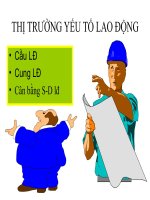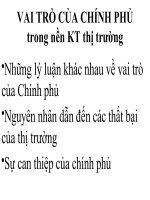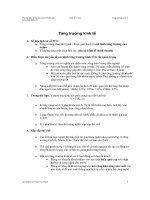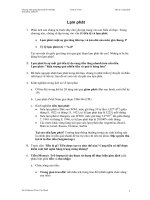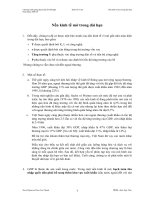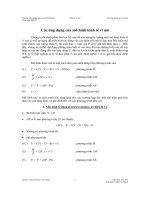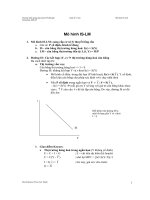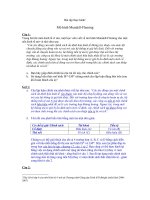- Trang chủ >>
- Đại cương >>
- Kinh tế vi mô
Basic concepts in economics (KINH tế VI mô SLIDE)
Bạn đang xem bản rút gọn của tài liệu. Xem và tải ngay bản đầy đủ của tài liệu tại đây (240.77 KB, 34 trang )
MICROECONOMICS
For Undergraduates
SYLLABUS
Objectives: to improve economic literacy as
well as critical thinking and problem solving
skills to explain and predict economic issues.
Pre-requisites: Math
Student task:
Class attendance (90%)
Actively participate in-class activity
Complete all homework and other tasks
Don’t have private conversation or arrive at
class late, which can disrupt the learning
environment of the class
BOOKS AND READING
Mankiw,N.Gregory,(2009) Principles of
Economics -Fifth edition, South Western
CENGAGE Learning.
David Begg, Economics, 8th edition, Mc Graw
Hill Education
Lecture’s slides
TOPICS IN MICROECONOMICS
1.
2.
3.
4.
5.
6.
Basic concepts in economics
and microeconomics.
Demand and supply
Consumer Behavior
Producer Behavior.
Market structures
The role of the Government in
the economy.
MICROECONOMICS
LECTURE 1
Basic concepts in economics
and microeconomics
1. ECONOMICS
Physicists try to explain the
existence of black holes in outer
space.
Biologists try to explain why
dinosaurs became extinct,
Economists try to explain puzzling
observations and facts about the
economy.
WHAT IS ECONOMICS?
Economy – “oikonomos” (Greek):
“One who manages a household”
Household - many decisions of
allocate limited resources
Society - many decisions
Allocate resources
Allocate output
1.1Resources
Land: Nature resouces
Labor (L):
Capital: Physical capital (K)
Entrepreneurship
Resources are scarce
1.2 WHAT IS
ECONOMICS?
Economics is to study of how
society manages its scarce
resources
Economists study:
How people make decisions
How people interact with one
another
Analyze forces and trends that
affect the economy as a whole
FOUNDATIONS OF MODERN
ECONOMICS
CLASSICAL
ADAM SMITH: The Wealth of Nations (1776)
ALFRED MARSHALL: Principles of
Economics (1890).
NEOCLASSICAL
During the 1940s - 1950s
Modern classical school of economics with
5 key ideas.
KEY IDEAS OF NEOCLASSICAL
ECONOMICS
Scarcity
Opportunity cost
Thinking at the margin
Incentives in individual decision
making
The role of the markets
Market failure.
1.3 The scientific method
Observation, theory, and more
observation
Observation
Theory
Conducting experiments
Observation
12
ECONOMIC MODELS
Economic model: an explanation of how
the economy or part of the economy
works.
Assumption: Judgements about features
that can be ignored to make the world
easier to understand.
Ceteris paribus assumption: All other
things being equal. The term refers to
holding all other variables constant when
one variable is changed.
Economic model
Come in many forms:
Numerical tables
Graphs
Algebraic equations
Wordy descriptions
Our first model: The circular-flow
diagram
Visual model of the economy
Shows how dollars flow through
markets among households and firms
Decision makers
Firms & Households
Markets
For gods and services
For factors of production
15
Our first model: The circular-flow
diagram
Firms
Produce goods and services
Use factors of production / inputs
Households
Own factors of production
Consume goods and services
16
The circular flow
17
1.4 Microeconomics and
Macroeconomics
Microeconomics
The study of how households and firms
make decisions
And how they interact in markets
Macroeconomics
The study of economy-wide phenomena,
including inflation, unemployment, and
economic growth
1.5 Economics and Policy
L A IS S E Z F A IR E
A d a m S m it h
L it t le G o v e r n m e n t c o n t r o l
MARKET ECONOMY
COMMAND ECONOMY
F r e e l y d e t e r m in e d p r ic e s
F r e e e x c h a n g e o f g o o d s a n d s e r v ic e s i n m a r k e t s
( C e n t r a ll y p la n n e d e c o n o m y )
G o v e r n m e n t d e t e r m in e s p r ic e s a n d p r o d u c t i o n .
M IX E D E C O N O M Y
A m a rk e t e c o n o m y w h e re
t h e G o v e r n m e n t p la y s a la r g e r o le .
Three Questions
What is to be produced?
How are the goods to be produced?
How can resources be used
efficiently?
For whom are the goods to be
produced?
The market economies
What are the key elements of the
market economy?
Freely determined price
Property rights and incentives
Competitive markets
Freedom to trade at home and abroad
A role for the Government.
The role of NGOs.
2. The optimum
economic choice
2.1.People face trade-
offs
Make decisions: Compare cost
with benefits of alternatives
2.2 Opportunity cost
OC: Whatever must be given up
to obtain one item
Tool for choice
Second model: The production possibilities
frontier
Production possibilities frontier
A graph
Combinations of output that the
economy can possibly produce
Given the available
Factors of production
Production technology
25

